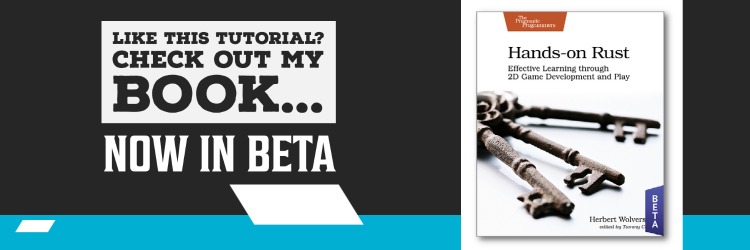This tutorial is free and open source, and all code uses the MIT license - so you are free to do with it as you like. My hope is that you will enjoy the tutorial, and make great games!
If you enjoy this and would like me to keep writing, please consider supporting my Patreon.
Cleaning Up the Sandbox
The template was written really quickly, and that tends to result in poor code choices. A couple of things bugged me, so I took a moment to clean them up.
Creating a Render Module
I didn't like having my render code mixed in with my turn state in main.rs. So I created a new module called render. To do this:
- Create a new directory,
src/render. - Create a new file,
src/render/mod.rs. - In the imports in
main.rs, addmod render;.
This leaves the following directory structure:
- src
- components
description.rsglyph.rsmod.rsposition.rstags.rs
- map
- layerbuilder
mod.rsentrance.rs
layer.rsmap.rsmod.rstile.rs
- layerbuilder
- render
mod.rs
main.rs
- components
- wasm_help
index.html
Cargo.toml
Populating the Render Module
In the render/mod.rs file, I started out with some imports:
#![allow(unused)] fn main() { use bracket_lib::prelude::*; use legion::*; use crate::map::{ Map, WIDTH, HEIGHT }; use crate::components::{Position, Glyph}; }
I actually cheated a bit, and let rust-analyzer help me with this. I then copied the render_glyphs function from main.rs and turned it into a stand-alone function in render/mod.rs:
#![allow(unused)] fn main() { pub fn render_glyphs(ctx: &mut BTerm, ecs: &World, map: &Map) { let mut query = <(&Position, &Glyph)>::query(); query.for_each(ecs, |(pos, glyph)| { if pos.layer == map.current_layer as u32 { ctx.set( pos.pt.x + 1, pos.pt.y + 1, glyph.color.fg, glyph.color.bg, glyph.glyph, ); } }); } }
No real changes, other than it doesn't access self - and takes the ECS and map as parameters.
I then grabbed the ugly box drawing code from main.rs and put it into another stand-alone function:
#![allow(unused)] fn main() { pub fn render_ui_skeleton(ctx: &mut BTerm) { ctx.draw_hollow_box(0, 0, WIDTH+1, HEIGHT+1, GRAY, BLACK); ctx.print_color(2, 0, WHITE, BLACK, "┤ SecBot 2021 7DRL ├"); ctx.draw_hollow_box(WIDTH+1, 0, 30, HEIGHT+1, GRAY, BLACK); ctx.set(WIDTH+1, 0, GRAY, BLACK, to_cp437('┬')); ctx.set(WIDTH+1, HEIGHT+1, GRAY, BLACK, to_cp437('┴')); } }
Updating the Main File
I opened up main.rs and cleaned it up to use these functions rather than containing the logic itself. The tick function became:
#![allow(unused)] fn main() { impl GameState for State { fn tick(&mut self, ctx: &mut BTerm) { ctx.cls(); render::render_ui_skeleton(ctx); self.map.render(ctx); render::render_glyphs(ctx, &self.ecs, &self.map); } } }
Then delete the render_glyphs function from main.rs.
This doesn't change any functionality, so I didn't include an example or screenshot for it.
Adding a LICENSE and README
I went ahead and added a LICENSE file to the root of the project. It's the standard MIT license, allowing you to do whatever you like with the code. I also created a minimal README.md file for the Github front page:
# SecBot - 7 Day Roguelike Challenge (2021)
This is my 7DRL entry. I'll keep adding to it here as I work on it. I'll keep a playable [WASM/WebGL Version](http://bfnightly.bracketproductions.com/secbot2021/) updated as well.
I can my webglbuild.bat file, and uploaded the resulting minimal program to my server - and tested that I had a working program in WASM land.
Pushing to Github
Finally, I connected my local repo to the Github Repo I'd made for the project and pushed everything upstream.
Onwards!
With the cleaning done, it was time to add some turn state and modal rendering.
